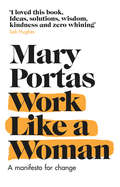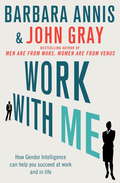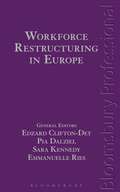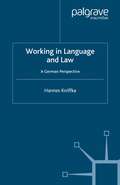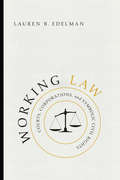- Table View
- List View
Work Beyond the Pandemic: Towards a Human-Centred Recovery
by Tindara Addabbo Edoardo Ales Ylenia Curzi Tommaso Fabbri Olga Rymkevich Iacopo SenatoriThis book addresses the impact of Covid-19 on employment relations and provides a reconstruction and a critical assessment of the measures enacted worldwide to tackle the economic and social crisis triggered by the global health emergency. The pandemic has been a booster of critical issues that for years have been silently shaping society and the labor market and so it can represent an opportunity to relaunch a critical analysis on the future of work.Beginning from this assumption, this book collects contributions from different disciplines, including law, economics and organization theory. It covers topics such as the measures enacted to protect workers’ health and cushion the labour, the new inequalities that emerged during the pandemic and the strategies to construct a sustainable and human-centred development in the post pandemic scenario. It is highly relevant to scholars and students of organisation studies, resilience, the labour market and labour law.
Work, Inheritance, and Deserts in Joseph Conrad’s Fiction
by Evelyn Tsz ChanThis book focuses on the complex relationships between inheritance, work, and desert in literature. It shows how, from its manifestation in the trope of material inheritance and legacy in Victorian fiction, “inheritance” gradually took on additional, more modern meanings in Joseph Conrad’s fiction on work and self-making. In effect, the emphasis on inheritance as referring to social rank and wealth acquired through birth shifted to a focus on talent, ability, and merit, often expressed through work.The book explores how Conrad’s fiction engaged with these changing modes of inheritance and work, and the resulting claims of desert they led to. Uniquely, it argues that Conrad’s fiction critiques claims of desert arising from both work and inheritance, while also vividly portraying the emotional costs and existential angst that these beliefs in desert entailed. The argument speaks to and illuminates today’s debates on moral desert arising from work and inheritance, in particular from meritocratic ideals. Its new approach to Conrad’s works will appeal to students and scholars of Conrad and literary modernism, as well as a wider audience interested in philosophical and social debates on desert deriving from inheritance and work.
Work-Life Balance in the Modern Workplace (Bulletin of Comparative Labour Relations Series)
by Sarah De GrooThe term ‘work-life balance’ refers to the relationship between paid work in all of its various forms and personal life, which includes family but is not limited to it. In addition, gender permeates every aspect of this relationship. This volume brings together a wide range of perspectives from a number of different disciplines, presenting research ndings and their implications for policy at all levels (national, sectoral, enterprise, workplace). Collectively, the contributors seek to close the gap between research and policy with the intent of building a better work-life balance regime for workers across a variety of personal circumstances, needs, and preferences. Among the issues and topics covered are the following: – differences and similarities between men and women and particularly between mothers and fathers in their work choices; – ‘third shift’ work (work at home at night or during weekends); – effect of the extent to which employers perceive management of this process to be a ‘burden’; – employers’ exploitation of the psychological interconnection between masculinity and breadwinning; – organisational culture that is more available for supervisors than for rank and le workers; – weak enforcement mechanisms and token penalties for non-compliance by employers; – trade unions as the best hope for precarious workers to improve work-life balance; – crowd-work (on-demand performance of tasks by persons selected remotely through online platforms from a large pool of potential and generic workers); – an example of how to use work-life balance insights to evaluate the law; – collective self-scheduling; – employers’ duty to accommodate; and – nancial hardship as a serious threat to work-life balance. As it has been shown clearly that work-life con ict is associated with negative health outcomes, exacerbates gender inequalities, and many other concerns, this unusually rich collection of essays will resonate particularly with concerned lawyers and legal academics who ask what work-life balance literature has to offer and how law should respond.
Work Like a Woman: A Manifesto For Change
by Mary Portas‘Grey suits are the accepted uniform of working men in positions of power. So ... what will they make of me when I appear on the podium in floral trousers and a cobalt blue jacket?’Mary Portas is calling time on alpha culture at work. In her must-read manifesto she suggests a radical change to the way we work, one that will allow all of us - men and women - to reach our full potential. But she can’t do this alone. Change only happens when we all come together.Are you ready? It’s time to #WorkLikeAWoman.
The Work of the British Law Commissions: Law Reform... Now?
by Shona Wilson StarkThe Law Commission (of England and Wales) and the Scottish Law Commission were both established in 1965 to promote the reform of the laws of their respective jurisdictions. Since then, they have each produced hundreds of reports across many areas of law. They are independent of government yet rely on governmental funding and governmental approval of their proposed projects. They also rely on both government and Parliament (and, occasionally, the courts or other bodies) to implement their proposals. This book examines the tension between independence and implementation and recommends how a balance can best be struck. It proposes how the Commissions should choose their projects given that their duties outweigh their resources, and how we should assess the success, or otherwise, of their output. Countries around the world have created law reform bodies in the Commissions' image. They may wish to reflect on the GB Commissions' responses to the changes and challenges they have faced to reappraise their own law reform machinery. Equally, the GB Commissions may seek inspiration from other commissions' experiences. The world the GB Commissions inhabit now is very different from when they were established. They have evolved to remain relevant in the face of devolution, the UK's changing relationship with the European Union, increasing pressure for accountability and decreasing funding. Further changes to secure the future of independent law reform are advanced in this book.
The Work of the British Law Commissions: Law Reform... Now?
by Shona Wilson StarkThe Law Commission (of England and Wales) and the Scottish Law Commission were both established in 1965 to promote the reform of the laws of their respective jurisdictions. Since then, they have each produced hundreds of reports across many areas of law. They are independent of government yet rely on governmental funding and governmental approval of their proposed projects. They also rely on both government and Parliament (and, occasionally, the courts or other bodies) to implement their proposals. This book examines the tension between independence and implementation and recommends how a balance can best be struck. It proposes how the Commissions should choose their projects given that their duties outweigh their resources, and how we should assess the success, or otherwise, of their output. Countries around the world have created law reform bodies in the Commissions' image. They may wish to reflect on the GB Commissions' responses to the changes and challenges they have faced to reappraise their own law reform machinery. Equally, the GB Commissions may seek inspiration from other commissions' experiences. The world the GB Commissions inhabit now is very different from when they were established. They have evolved to remain relevant in the face of devolution, the UK's changing relationship with the European Union, increasing pressure for accountability and decreasing funding. Further changes to secure the future of independent law reform are advanced in this book.
Work with Me: How gender intelligence can help you succeed at work and in life
by John Gray Barbara AnnisDespite the strenuous efforts to give women equal status in the workplace over the last few decades, tension between the sexes in the workplace remains as rampant as ever: during exit interviews many women, often leaving to start their own businesses, cite feeling undervalued or unappreciated at the office. Despite countless company initiatives, equality protocols, and gender seminars we have made little significant advancement. So why can't the sexes work together?In this fresh exploration of the relationships between men and women in the office, world-renowned expert on gender issues in the workplace, Barbara Annis, and John Gray, author of the number one relationship book of all time, Men are from Mars, Women are from Venus, team up to reveal the eight gender blindspots that create friction between the sexes at work. Annis and Gray use stories, science and research (including over 100,000 in-depth interviews of male and female executives in over 60 Fortune 500 companies) to expose the blindspots that cause misunderstandings, miscommunications, mistrust, resentment and frustrations. Filled with 'ah-ha' moments, Work with Me provides a blueprint for boosting your gender intelligence. It provides new insights and solutions that will help break down barriers and enable men and women to bridge their different values, build trust and increase their credibility with each other, at work and at home.
Workbook for Criminology: Book One
by Rob Webb Annie TownendThis is a student workbook to accompany Criminology Book One for the WJEC Level 3 Applied Certificate and Diploma published by Napier Press.
The Worker Center Handbook: A Practical Guide to Starting and Building the New Labor Movement
by Kim Bobo Marien Casillas PabellonWorker centers are becoming an important element in labor and community organizing and the struggle for fair pay and decent working conditions for low-wage workers, especially immigrants. There are currently more than two hundred worker centers in the country, and more start every month. Most of these centers struggle as they try to raise funds, maintain stable staff, and build a membership base. For this book, Kim Bobo and Marién Casillas-Pabellón, two women with extensive experience supporting and leading worker centers, have interviewed staff at a broad range of worker centers with the goal of helping others understand how to start and build their organizations. This book is not theoretical, but rather is designed to be a practical workbook for staff, boards, and supporters of worker centers. Geared toward groups that want to build worker centers, this book discusses how to survey the community, take on an initial campaign, recruit leaders, and raise seed funds. Bobo and Casillas-Pabellón also provide a wealth of advice to help existing centers become stronger and more effective. The Worker Center Handbook compiles best practices from around the country on partnering with labor, enlisting the assistance of faith communities and lawyers, raising funds, developing a serious membership program, integrating civic engagement work, and running major campaigns. The authors urge center leaders to both organize and build strong administrative systems. Full of concrete examples from worker centers around the country, the handbook is practical and honest about challenges and opportunities.
Worker Cooperatives in India
by Timothy Kerswell Surendra PratapThis book discusses the experiences of cooperative enterprises in India that have been operated by or influenced to a significant extent by trade unions. It describes the origins of these movements in India presenting a political-strategic view of their development and, in some cases, their decline. The book also presents case studies of groundbreaking social experiments conducted in India in which trade unions have formed cooperatives for production and service provision for the working class movement. It also offers lessons learned from previous social experiments and explains how to use them for future strategies in the working class movement by using primary research undertaken on trade union cooperatives in India. With globalization often given as a reason for the decline of trade unions and transformative social movements, this book demonstrates that where movements declined it was due to their own internal weaknesses, while presenting successful case studies of movements which have shown resilience in the face of globalization. The book also gives an extensive criticism of India’s Self Employed Women’s Association as a model of a depoliticized trade union cooperative. The main lesson of this book is that cooperatives represent a viable strategy to build working class power in the 21st century in India, and elsewhere.
Worker Cooperatives in India
by Timothy Kerswell Surendra PratapThis book discusses the experiences of cooperative enterprises in India that have been operated by or influenced to a significant extent by trade unions. It describes the origins of these movements in India presenting a political-strategic view of their development and, in some cases, their decline. The book also presents case studies of groundbreaking social experiments conducted in India in which trade unions have formed cooperatives for production and service provision for the working class movement. It also offers lessons learned from previous social experiments and explains how to use them for future strategies in the working class movement by using primary research undertaken on trade union cooperatives in India. With globalization often given as a reason for the decline of trade unions and transformative social movements, this book demonstrates that where movements declined it was due to their own internal weaknesses, while presenting successful case studies of movements which have shown resilience in the face of globalization. The book also gives an extensive criticism of India’s Self Employed Women’s Association as a model of a depoliticized trade union cooperative. The main lesson of this book is that cooperatives represent a viable strategy to build working class power in the 21st century in India, and elsewhere.
Workers, Collectivism and the Law: Grappling with Democracy (Elgar Studies in Law and Society)
by Laura CarlsonWorkers, Collectivism and the Law offers a captivating historical account of worker democracy, from its beginnings in European guild systems to present-day labor unions, across the national legal systems of Germany, Sweden, the United Kingdom and the United States. Analysing these legal systems in light of a Habermasian concept of participatory democracy, Laura Carlson identifies ways to strengthen individual employee voice in claims against employers. Carlson highlights how employee voice and democracy, both collective and individual, assume different guises in each of these four labor law models. By tracing voice and democracy as components in the history of collective worker organizations, from guilds to journeymen associations to modern labor unions, Carlson demonstrates how history has shaped today’s national labor law models. In the context of modern labor law’s central focus on human rights, Carlson articulates the need for stronger legal defence of mechanisms of transparency and procedural due process, to enhance voice and democracy for union members in invoking rights and asserting protections for workers. This insightful book is indispensable reading for labor law academics and for those practicing in employment law, while those interested in the history of labor law will revel in its penetrating survey of the materials.
Workforce Restructuring in Europe
by Miller Rosenfalck Llp Edzard Clifton-Dey Pia Dalziel Sara Kennedy Emmanuelle RiesThe brand new title that provides practical employment law guidance on HR restructuring matters across 30 European jurisdictions.Offering straightforward information on issues which are commonly faced by businesses during various kinds of restructuring, it looks at: the reorganisation of a workplace or group of companies; downsizing or closure of a business; restructuring due to relocation; and when outsourcing is being considered. The book assists readers to focus on what needs to be done 'now' as well as to plan for the timing, consultation, costs, morale implications and processes involved in each stage of the restructure.Individual 'State' chapters aid practical comparisonThese scenarios are examined across the 28 EU member states plus Norway and Switzerland, each in their own chapter, to allow for practical comparison across various jurisdictions. An introductory chapter on EU minimum standards helps the reader to place each country within the context of EU law. Each chapter follows the same template to allow for easy comprehension of how to approach the same issue across borders. They cover:-Employment Status-Process for individual redundancies -Process for collective redundancies -Works Council and consultation requirements-Employment implications of business transfers -Unilateral and mutually agreed changes to terms and conditions of employment Local status of legislation and case lawTo keep the book user-friendly, legislation and case law are addressed in such a way that presents the current local primary and secondary status of each, without excessive use of unnecessary citations. Who should consider buying this book?This is an essential title for all employment law practitioners and HR specialists who work for, or advise, businesses that have offices in multiple European states.
Working as Equals: Relational Egalitarianism and the Workplace
by Julian David Jonker and Grant J. RozeboomAre hierarchical arrangements in the workplace, including the employer-employee relationship, consistent with the ideal of relating to one another as moral equals? With this question at its core, this volume of essays by leading moral and political philosophers explores ideas about justice in the workplace, contributing to both political philosophy and business ethics. Relational egalitarians propose that the ideal of equality is primarily an ideal of social relationships and view the equality of social relationships as having priority over the distributive arrangements. Yet contemporary workplaces are characterized by hierarchical employer-employee relationships. The essays push discussions of the relational egalitarian tradition in new directions, helping to show its promise and its limits. They address pressing concerns at a time of widening inequality and rapid changes in the nature of work. The contributors explore two overarching topics. First, they consider whether the relational ideal of equality really applies to the workplace. In doing so, they explore the scope of the relational egalitarian approach and its promise for extending political philosophy beyond the institutions of the state. Second, they consider what workplace relations and workplace actors would have to be like in order to fulfill the relational egalitarian ideal. In examining these two issues, the contributors both flesh out the relational egalitarian ideal and add to our understanding of the ethical norms of the workplace. The book is an invaluable resource for those studying political philosophy and ethics, particularly relational egalitarianism. Additionally, lawyers interested in the foundations of labor law and antidiscrimination law will find it highly informative.
Working as Equals: Relational Egalitarianism and the Workplace
Are hierarchical arrangements in the workplace, including the employer-employee relationship, consistent with the ideal of relating to one another as moral equals? With this question at its core, this volume of essays by leading moral and political philosophers explores ideas about justice in the workplace, contributing to both political philosophy and business ethics. Relational egalitarians propose that the ideal of equality is primarily an ideal of social relationships and view the equality of social relationships as having priority over the distributive arrangements. Yet contemporary workplaces are characterized by hierarchical employer-employee relationships. The essays push discussions of the relational egalitarian tradition in new directions, helping to show its promise and its limits. They address pressing concerns at a time of widening inequality and rapid changes in the nature of work. The contributors explore two overarching topics. First, they consider whether the relational ideal of equality really applies to the workplace. In doing so, they explore the scope of the relational egalitarian approach and its promise for extending political philosophy beyond the institutions of the state. Second, they consider what workplace relations and workplace actors would have to be like in order to fulfill the relational egalitarian ideal. In examining these two issues, the contributors both flesh out the relational egalitarian ideal and add to our understanding of the ethical norms of the workplace. The book is an invaluable resource for those studying political philosophy and ethics, particularly relational egalitarianism. Additionally, lawyers interested in the foundations of labor law and antidiscrimination law will find it highly informative.
Working Collaboratively: A Practical Guide to Achieving More
by Penny WalkerThe really big sustainability challenges for your business can’t be solved by your business. But they can be solved by your business working in collaboration with others. Working Collaboratively provides tools to help you understand and manage successful collaborations: identify potential collaborators, e.g. key players from other parts of the system; spot internal "ways of working" that support or get in the way of collaboration; use a range of techniques to explore win-wins with potential collaborators. Collaboration means sharing decisions, resources, risks... and control. It means trusting others, sharing your weaknesses as well as your strengths and taking the time to find win-wins (or compromises). It requires a leap of faith, because you never know what will emerge from the chaotic early steps. Drawing on examples of collaboration between strange bedfellows, this practical guide will help you take the first steps towards building sustainable solutions together.
Working Collaboratively: A Practical Guide to Achieving More (Doshorts Ser.)
by Penny WalkerThe really big sustainability challenges for your business can’t be solved by your business. But they can be solved by your business working in collaboration with others. Working Collaboratively provides tools to help you understand and manage successful collaborations: identify potential collaborators, e.g. key players from other parts of the system; spot internal "ways of working" that support or get in the way of collaboration; use a range of techniques to explore win-wins with potential collaborators. Collaboration means sharing decisions, resources, risks... and control. It means trusting others, sharing your weaknesses as well as your strengths and taking the time to find win-wins (or compromises). It requires a leap of faith, because you never know what will emerge from the chaotic early steps. Drawing on examples of collaboration between strange bedfellows, this practical guide will help you take the first steps towards building sustainable solutions together.
Working Ethics: How to Be Fair in a Culturally Complex World
by Richard RowsonWorking Ethics sets out an ethical foundation for professionals and for the professions in a modern, culturally complex society. This book will be of interest to anyone who takes seriously their obligations to society as a whole and to the individuals with whom they work. Richard Rowson puts forward an ethical framework comprising four basic elements - fairness, respect for autonomy, integrity, and seeking the most beneficial and least harmful consequences. The three parts of the book explore: * sources of ethical guidance such as laws, social conventions, professional codes of conduct and religious beliefs, identifying the ethical values integral to the professions * the obligations these values give to members of the professions, and the ethical issues which arise when they are concerned to produce benefits and prevent harm, treat people fairly, respect others and act with integrity * how these values might be incorporated into professional practice. The book ends with a brief guide to dealing with blame in a professional context and claims about rights. At the end of each chapter, key questions encourage readers to think through the issues discussed. Rowson shows how this ethical framework can enable professionals to work more effectively, earn trust, mutual support and respect, and how it can foster democratic ideals in the workplace and community. This book will be essential reading for professionals in the public and private sector - including teachers, civil servants, police personnel, nurses, doctors, lawyers, accountants and engineers.
Working Ethics: How to Be Fair in a Culturally Complex World (PDF)
by Richard RowsonWorking Ethics sets out an ethical foundation for professionals and for the professions in a modern, culturally complex society. This book will be of interest to anyone who takes seriously their obligations to society as a whole and to the individuals with whom they work. Richard Rowson puts forward an ethical framework comprising four basic elements - fairness, respect for autonomy, integrity, and seeking the most beneficial and least harmful consequences. The three parts of the book explore: * sources of ethical guidance such as laws, social conventions, professional codes of conduct and religious beliefs, identifying the ethical values integral to the professions * the obligations these values give to members of the professions, and the ethical issues which arise when they are concerned to produce benefits and prevent harm, treat people fairly, respect others and act with integrity * how these values might be incorporated into professional practice. The book ends with a brief guide to dealing with blame in a professional context and claims about rights. At the end of each chapter, key questions encourage readers to think through the issues discussed. Rowson shows how this ethical framework can enable professionals to work more effectively, earn trust, mutual support and respect, and how it can foster democratic ideals in the workplace and community. This book will be essential reading for professionals in the public and private sector - including teachers, civil servants, police personnel, nurses, doctors, lawyers, accountants and engineers.
Working in Language and Law: A German Perspective
by H. KniffkaWorking in Language and Law is a detailed account of the forensic linguistic work done by the author in the last 35 years. It provides exemplary insights into an ever-expanding field of expert testimony, focusing on the situation in Germany since the seventies and covering all major areas of the field.
Working It Out
by Alex GeorgeWatch out Bridget Jones and Ally McBeal – Johnathan Burlip wants you to know his side of the story!
Working Law: Courts, Corporations, and Symbolic Civil Rights (Chicago Series in Law and Society)
by Lauren B. EdelmanSince the passage of the Civil Rights Act, virtually all companies have antidiscrimination policies in place. Although these policies represent some progress, women and minorities remain underrepresented within the workplace as a whole and even more so when you look at high-level positions. They also tend to be less well paid. How is it that discrimination remains so prevalent in the American workplace despite the widespread adoption of policies designed to prevent it? One reason for the limited success of antidiscrimination policies, argues Lauren B. Edelman, is that the law regulating companies is broad and ambiguous, and managers therefore play a critical role in shaping what it means in daily practice. Often, what results are policies and procedures that are largely symbolic and fail to dispel long-standing patterns of discrimination. Even more troubling, these meanings of the law that evolve within companies tend to eventually make their way back into the legal domain, inconspicuously influencing lawyers for both plaintiffs and defendants and even judges. When courts look to the presence of antidiscrimination policies and personnel manuals to infer fair practices and to the presence of diversity training programs without examining whether these policies are effective in combating discrimination and achieving racial and gender diversity, they wind up condoning practices that deviate considerably from the legal ideals.
Working Law: Courts, Corporations, and Symbolic Civil Rights (Chicago Series in Law and Society)
by Lauren B. EdelmanSince the passage of the Civil Rights Act, virtually all companies have antidiscrimination policies in place. Although these policies represent some progress, women and minorities remain underrepresented within the workplace as a whole and even more so when you look at high-level positions. They also tend to be less well paid. How is it that discrimination remains so prevalent in the American workplace despite the widespread adoption of policies designed to prevent it? One reason for the limited success of antidiscrimination policies, argues Lauren B. Edelman, is that the law regulating companies is broad and ambiguous, and managers therefore play a critical role in shaping what it means in daily practice. Often, what results are policies and procedures that are largely symbolic and fail to dispel long-standing patterns of discrimination. Even more troubling, these meanings of the law that evolve within companies tend to eventually make their way back into the legal domain, inconspicuously influencing lawyers for both plaintiffs and defendants and even judges. When courts look to the presence of antidiscrimination policies and personnel manuals to infer fair practices and to the presence of diversity training programs without examining whether these policies are effective in combating discrimination and achieving racial and gender diversity, they wind up condoning practices that deviate considerably from the legal ideals.
Working Law: Courts, Corporations, and Symbolic Civil Rights (Chicago Series in Law and Society)
by Lauren B. EdelmanSince the passage of the Civil Rights Act, virtually all companies have antidiscrimination policies in place. Although these policies represent some progress, women and minorities remain underrepresented within the workplace as a whole and even more so when you look at high-level positions. They also tend to be less well paid. How is it that discrimination remains so prevalent in the American workplace despite the widespread adoption of policies designed to prevent it? One reason for the limited success of antidiscrimination policies, argues Lauren B. Edelman, is that the law regulating companies is broad and ambiguous, and managers therefore play a critical role in shaping what it means in daily practice. Often, what results are policies and procedures that are largely symbolic and fail to dispel long-standing patterns of discrimination. Even more troubling, these meanings of the law that evolve within companies tend to eventually make their way back into the legal domain, inconspicuously influencing lawyers for both plaintiffs and defendants and even judges. When courts look to the presence of antidiscrimination policies and personnel manuals to infer fair practices and to the presence of diversity training programs without examining whether these policies are effective in combating discrimination and achieving racial and gender diversity, they wind up condoning practices that deviate considerably from the legal ideals.
Working Law: Courts, Corporations, and Symbolic Civil Rights (Chicago Series in Law and Society)
by Lauren B. EdelmanSince the passage of the Civil Rights Act, virtually all companies have antidiscrimination policies in place. Although these policies represent some progress, women and minorities remain underrepresented within the workplace as a whole and even more so when you look at high-level positions. They also tend to be less well paid. How is it that discrimination remains so prevalent in the American workplace despite the widespread adoption of policies designed to prevent it? One reason for the limited success of antidiscrimination policies, argues Lauren B. Edelman, is that the law regulating companies is broad and ambiguous, and managers therefore play a critical role in shaping what it means in daily practice. Often, what results are policies and procedures that are largely symbolic and fail to dispel long-standing patterns of discrimination. Even more troubling, these meanings of the law that evolve within companies tend to eventually make their way back into the legal domain, inconspicuously influencing lawyers for both plaintiffs and defendants and even judges. When courts look to the presence of antidiscrimination policies and personnel manuals to infer fair practices and to the presence of diversity training programs without examining whether these policies are effective in combating discrimination and achieving racial and gender diversity, they wind up condoning practices that deviate considerably from the legal ideals.



